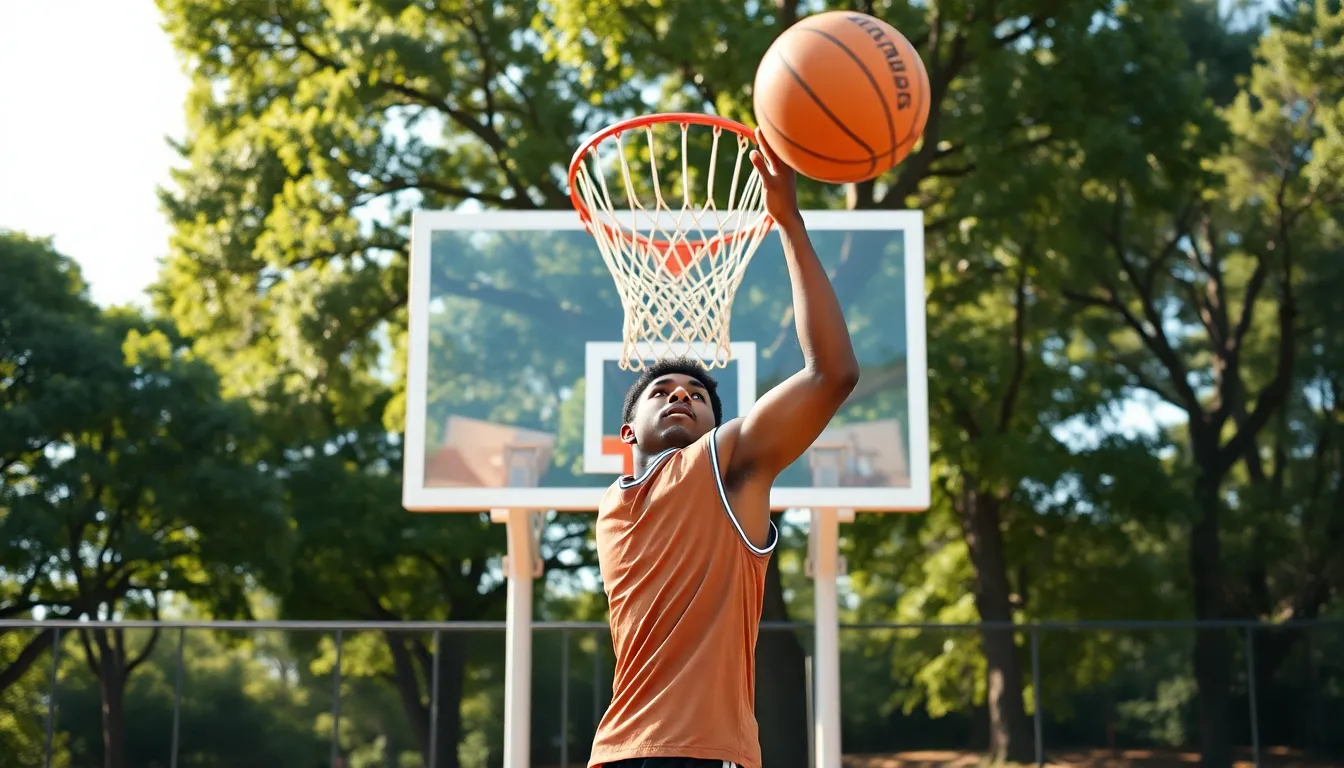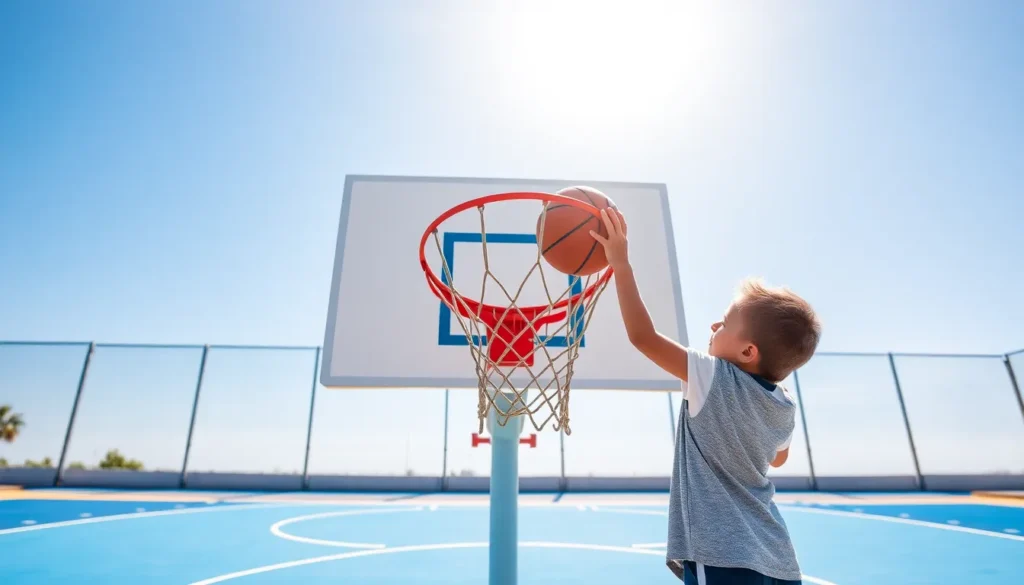Table of Contents
ToggleWhen it comes to basketball, size matters—especially when it comes to hoops. But are all basketball hoops created equal? Picture this: a 5-foot-tall kid trying to dunk on a regulation hoop. Spoiler alert: it’s not going to end well. Understanding hoop sizes can mean the difference between a slam dunk and a painful faceplant.
Not only do different sizes cater to varying skill levels, but they also affect how the game is played. From backyard setups to professional arenas, the dimensions can vary more than a player’s shoe size. So before you lace up those sneakers and hit the court, let’s dive into the world of basketball hoops and discover if they’re all the same size or if there’s more to this game than meets the eye.
Overview Of Basketball Hoop Sizes
Basketball hoops come in various sizes, each serving specific purposes and player demographics. The official height of a regulation hoop stands at 10 feet. Youth leagues often use adjustable hoops, allowing heights to vary from 8 to 10 feet, accommodating younger players and beginners.
Diameter also plays a critical role in hoop specifications. Standard hoops feature a rim diameter of 18 inches. Adjustable systems may include alternate rim sizes that suit different age groups or skill levels. For example, some beginner hoops provide wider rims to enhance shooting success.
Backboard dimensions are another vital aspect to consider. Professionally, backboards measure 72 inches in width and 42 inches in height. Youth systems may utilize smaller backboards, which can measure 48 or 54 inches wide. This variability affects how players perceive distance and angles while shooting.
Materials contribute significantly to the overall quality of basketball hoops. Durable systems often include tempered glass backboards. Some entry-level options feature acrylic or polycarbonate backboards for affordability and portability.
Understanding basketball hoop sizes helps players select the right equipment suitable for their skill level and age. Different sizes can impact gameplay, affecting shooting accuracy and overall performance. When choosing a hoop, players need to consider their current abilities and how they might progress over time.
Standard Basketball Hoops

Standard basketball hoops come in various sizes and designs, catering to different skill levels and age groups.
Regulation Sizes
Regulation basketball hoops stand at 10 feet, the official height for professional and collegiate play. Many youth leagues opt for adjustable hoops, which can range from 8 to 10 feet to accommodate developing players. These adjustable systems provide flexibility, allowing children to gradually transition to standard heights as their skills improve. The rim diameter remains constant at 18 inches, ensuring consistency across various competitional formats. Ultimately, understanding these standard sizes helps players choose appropriate equipment.
Variations in Design
Basketball hoop designs vary significantly depending on the intended use. Professional systems typically feature tempered glass backboards measuring 72 inches by 42 inches for better rebounding and shot accuracy. Youth systems often utilize smaller acrylic or polycarbonate backboards that measure 54 inches or less. These materials offer differing durability and cost-effectiveness, impacting the decision-making process for parents and organizations. Adjustments in the hoop’s design also include changes to the rim, with some models providing wider openings for enhanced shooting success among beginners.
Youth Basketball Hoops
Youth basketball hoops cater to young players, providing various options to accommodate differing skill levels. These hoops promote growth and development in the sport.
Adjustable Heights
Adjustable hoops play a vital role in youth basketball. Height settings range from 8 feet to 10 feet, allowing players to find their optimal shooting level. Many systems enable easy adjustments, ensuring that young athletes can modify the height as they improve. Such flexibility aids in building confidence and enhancing shooting skills tailored to their growth.
Size Differences
Size variations in youth basketball hoops are significant. Standard youth rim diameters remain at 18 inches, just like regulation hoops. Yet, some hoops designed for beginners might feature wider rims to enhance shooting success. Backboard dimensions can vary as well, with youth systems often smaller than professional standards. Commonly, youth backboards measure around 54 inches by 34 inches, prioritizing approachability and effective play for younger players.
Specialty Basketball Hoops
Specialty basketball hoops provide various options tailored for specific needs and preferences. These hoops enhance gameplay experiences while catering to different player skill levels.
Portable Hoops
Portable hoops offer flexibility and convenience, making them ideal for casual players and families. Many portable models come with adjustable heights, often ranging from 7.5 to 10 feet. This feature allows users to customize the hoop height for different players, promoting skill development and enjoyment. Made with durable materials, portable hoops can be easily moved, set up, and stored. Some models include weighted bases, ensuring stability during play. These adjustable systems can accommodate various skill levels, enhancing shooting confidence and performance on the court.
In-Ground Hoops
In-ground hoops provide a more permanent structure, often preferred by serious players and enthusiasts. Secured firmly into the ground, these hoops deliver superior stability during intense gameplay. Many in-ground models feature adjustable heights too, with standard settings between 10 and 8 feet. Backboards on in-ground systems typically consist of tempered glass, offering better rebound performance compared to portable hoops. They also come in various sizes, including the professional standard of 72 inches wide. Investing in an in-ground hoop can significantly improve a player’s overall experience, enabling competitive practice and skill refinement.
Factors Affecting Size Perception
Variations in basketball hoop size stem from multiple factors. These include player age, skill level, and the playing environment.
Player Age and Skill Level
Age and ability significantly influence hoop requirements. Young players benefit from adjustable hoops, which cater to their developmental needs. For instance, youth leagues commonly utilize heights from 8 to 10 feet, allowing gradual skill advancement. Older players typically use standard 10-foot hoops, promoting competitive play. Skill level also determines preferences; beginners may prefer wider rim openings to enhance shooting success, while experienced players perform better with standard dimensions. Tailoring hoop sizes to age and ability promotes effective training and confidence.
Playing Environment
The playing environment also impacts perceptions of hoop size. Outdoor courts often host portable hoops that adjust from 7.5 to 10 feet, providing flexibility. Indoor facilities typically feature fixed 10-foot hoops, ensuring a consistent experience for advanced players. Factors like surface material can affect play; a sturdy surface enhances performance and rebound quality. Additionally, space limitations might demand smaller setups, affecting players’ training effectiveness and confidence. Choosing the right hoop based on environment enhances gameplay and skill development.
Basketball hoop sizes play a crucial role in shaping the game for players of all ages and skill levels. The variations in height rim diameter and backboard dimensions cater to specific needs ensuring that everyone can enjoy the sport. From adjustable hoops for young players to standard regulation setups for competitive play the right hoop can significantly enhance a player’s experience.
Understanding these differences allows players to choose the best equipment for their development and enjoyment. Whether for casual play or serious training selecting the appropriate hoop size is essential for improving skills and achieving success on the court.




